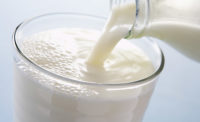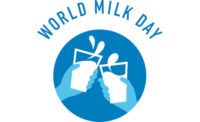Today is World Milk Day, and although dairy still has much to overcome, it also has reason to celebrate.
Retail-sales as reported by Chicago-based market research firm IRI over the past three months show that consumers have reacted to the coronavirus crisis first by stocking up on dairy, then by continuing to buy milk and other products at disproportionately high levels, the Arlington, Va.-based National Milk Producers Federation (NMPF) said.
From March 8 to March 22, as stay-at-home orders and business closures proliferated nationwide, dairy products flew from store shelves. Milk sales were 43% higher than during the same period a year earlier. Yogurt rose 31%. Ice cream sales rose 40%, while cheese sales saw a 76% gain. Butter sales more than doubled during the same period, NMPF said.
Gains have continued into the “new normal.” Retail dairy sales from late March through May 17 remain 25% higher than a year ago, NMPF, while overall grocery sales during that same period are only up 14% meaning that at a time when people are relying more on grocers to fill their needs, they’re relying on dairy significantly more than they are on other products.
That vote of consumer trust shows every sign of continuing for the foreseeable future, NMPF said. When milk is already in 94% of U.S. households, it follows that it would be especially important as families choose how to weather a storm.
This real-world, real-time affirmation of dairy’s value can’t help but inspire the entire dairy community to keep working and maintain resilience through whatever comes next, NMPF said. Dairy owes a deep debt of gratitude to consumers whose support has helped carry farmers through this crisis.
Of course, consumer faith has been only one part of dairy’s story in the past few months. Pre-coronavirus, about half of all dairy sales came from outside the home. Even as retail consumers increased dairy buying, sales to restaurants, schools and cafeterias plunged. That turbulence prompted sharp declines in the USDA’s forecast for milk prices for 2020. That’s been a big reason why federal assistance for dairy farms has been so important, NMPF noted.
But even that story is brightening. A recent price rally is changing the outlook from mortifying to merely difficult — still cold comfort for many producers, but more manageable in a way many wouldn’t have dared to wish for even one month ago, NMPF said. Restaurant sales are slowly returning, and federal aid has provided a meaningful boost to bottom lines, even as signs of stress will still need to be monitored and additional aid will be necessary.
The past few months have been difficult for dairy, as they have for everyone. The next few will be as well. But dairy is resilient, NMPF said. Its value to consumers is beyond dispute, and early signs of recovery give reasons for hope.






